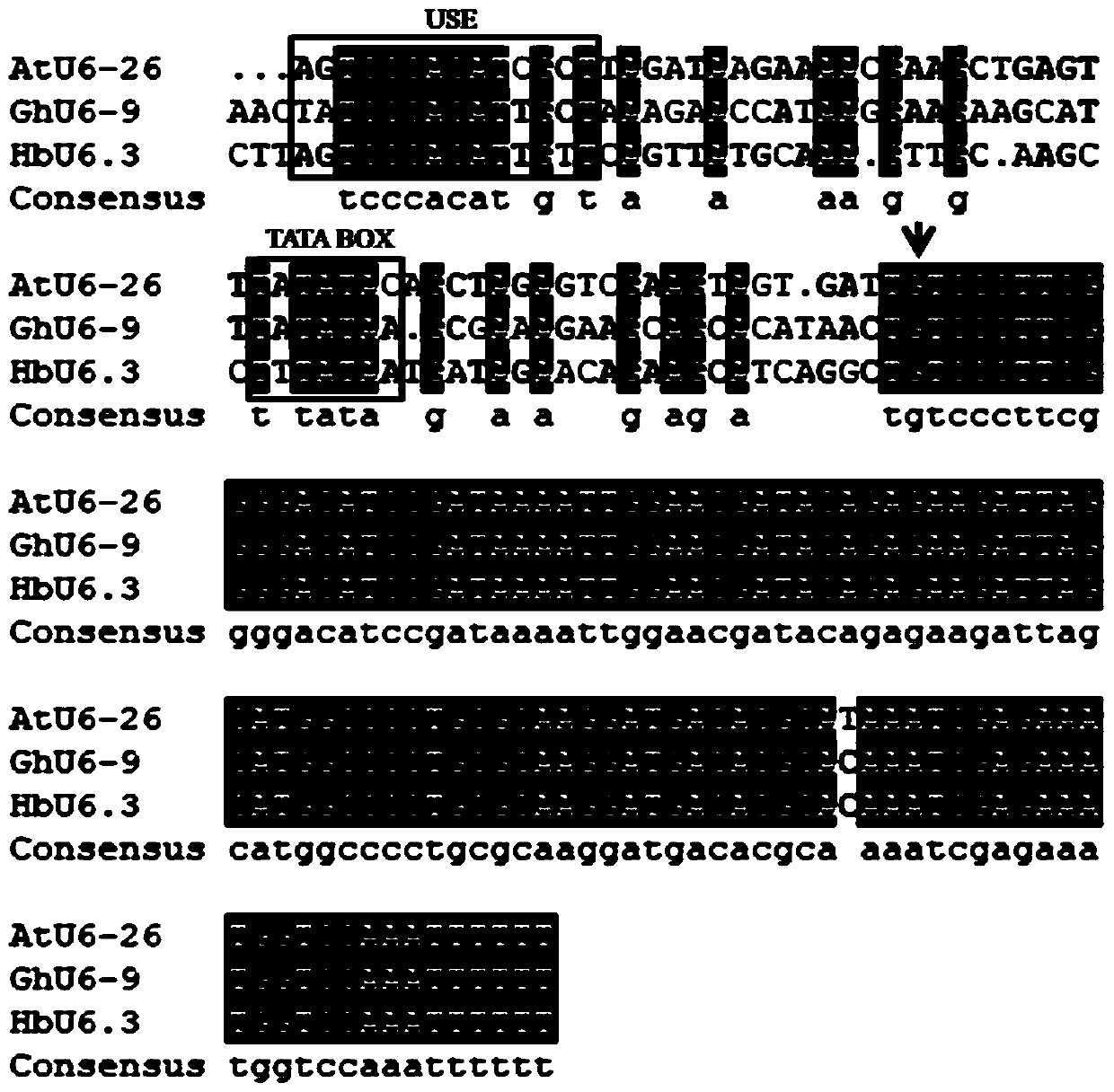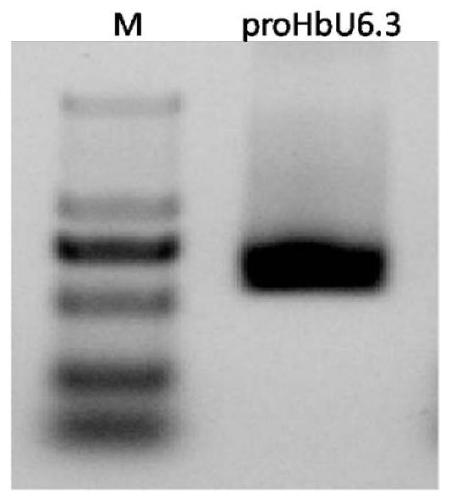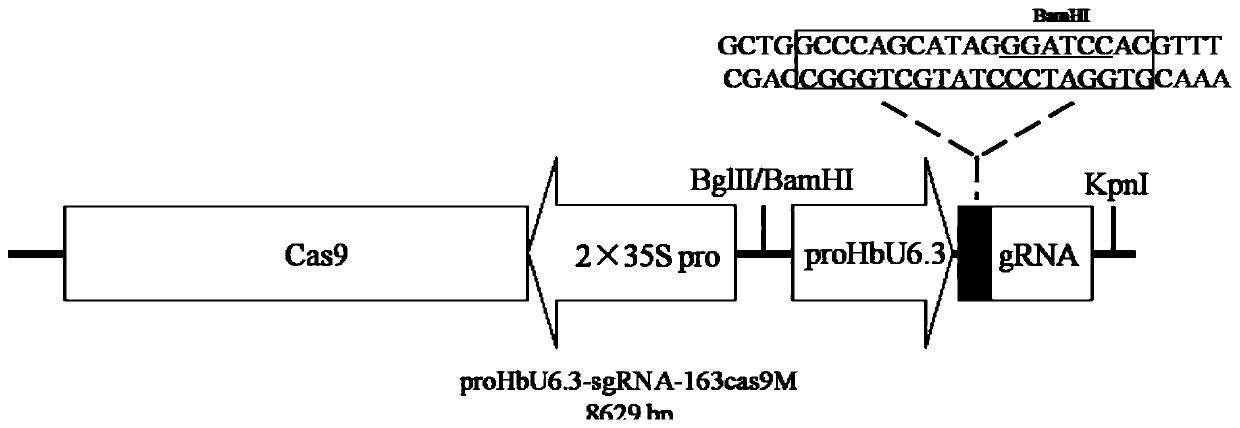Rubber tree U6 gene promoter proHbU6.3 and clone and applications thereof
A prohbu6.3-sk-5g, prohbu6.3-sgrna-163cas9m technology is applied in the fields of Hevea U6 gene promoter proHbU6.3 and Hevea RNA polymerase type III promoter, which can solve the problems of limited application and achieve high efficiency The effect of precise varieties and high-efficiency transcriptional activity
- Summary
- Abstract
- Description
- Claims
- Application Information
AI Technical Summary
Problems solved by technology
Method used
Image
Examples
Embodiment 1
[0051] The acquisition of embodiment 1 Hevea brasiliensis U6 gene promoter proHbU6.3
[0052] Using the DNA sequences of Arabidopsis thaliana AtU6-26 gene (Genebank accession number: X52528.1) and cotton GhU6-9 gene (Genebank accession number: XR_001680717.1) as reference, we searched the rubber tree genome database (hevea.catas. cn), found a rubber tree HbU6 gene (Genebank accession number: XR_002491075.1) by means of homologous alignment, and obtained the upstream reference sequence of this gene.
[0053] Using the genomic DNA of the leaves of Hevea brasiliensis Reyan 7-33-97 (developed by the Rubber Research Institute of the Chinese Academy of Tropical Agricultural Sciences) as a template, design the following proHbU6.3-F and proHbU6.3-R specific primers to clone the 546bp DNA of the promoter region Fragment:
[0054] proHbU6.3-F:GAACCATATGCTTAGTTCATCTTTC;
[0055] proHbU6.3-R: CAGCCTGATGCTTCTGTTCTATC;
[0056] KOD FX enzyme (TOYOBO) was used to carry out PCR amplificati...
Embodiment 2
[0059] The construction of embodiment 2 rubber tree gene editing vector
[0060] (1) proHbU6.3 was constructed on the intermediate vector SK-5G vector
[0061] Digest the SK-5G vector and the downstream gRNA fragment with SalI and XhoI, remove the rice U3 promoter on the vector, recover the 2913bp vector backbone fragment, and design primers:
[0062] proHbU6.3-lF:
[0063] GCGGCCGCAGATCTGCTAGCGTCGAC GAACCATATGCTTAGTTCATC;
[0064] proHbU6.3-lR:
[0065] GTGTTGTGTTCACCTGCGAGC CAGCCTGATGCTTCTGTTC
[0066] (The underlined sequence is homologous to the SK-5G vector).
[0067] Using the rubber tree genomic DNA as a template, use KOD FX enzyme (TOYOBO) in a 20μl reaction system for pre-denaturation at 95°C for 2min, denaturation at 98°C for 10s, annealing at 60°C for 30s, extension at 72°C for 1min, 35 cycles, and final extension at 72°C for 5min. The proHbU6.3 promoter fragment was increased, and SK-5G vector homologous sequences were introduced at both ends.
[0068] Des...
Embodiment 3
[0083] Embodiment 3 Hevea protoplast transformation
[0084] In this example, the PEG-mediated editing vector proHbU6.3-sgRNA-163Cas9M was used to transform Hevea protoplasts, and the 163Cas9M vector without the sgRNA expression cassette was used as a control.
[0085] Transfer the rubber tree Reyan 7-33-97 tissue culture seedlings that have been cultivated for one month to 26-28°C for 5-7 days in the dark, and take 2g of leaves at the discoloration stage and immediately soak them in 0.6M mannitol solution for 10 minutes before preparing protoplast. The preparation and transformation process of protoplasts refer to (Yoo, S.D. et al., 2007, Nature Protocols, 2:1565-1575.). The transformed protoplasts were cultured in the dark at 26-28°C for 48 hours and then used for detection of target site mutations.
PUM
 Login to View More
Login to View More Abstract
Description
Claims
Application Information
 Login to View More
Login to View More - R&D
- Intellectual Property
- Life Sciences
- Materials
- Tech Scout
- Unparalleled Data Quality
- Higher Quality Content
- 60% Fewer Hallucinations
Browse by: Latest US Patents, China's latest patents, Technical Efficacy Thesaurus, Application Domain, Technology Topic, Popular Technical Reports.
© 2025 PatSnap. All rights reserved.Legal|Privacy policy|Modern Slavery Act Transparency Statement|Sitemap|About US| Contact US: help@patsnap.com



